The madness that engulfed the inhabitants of this small American settlement in the 17th century led to a tragedy. The trial dragged on for months, people were throwing around with accusations. Record of dead people:fourteen women, five men and two dogs. Why did the "Salem witches" have to die?
For a long time, it seemed that the British colonies in the New World were not carried away by the madness that had haunted Europe since the end of the Middle Ages. Witch trials were rare here and, interestingly, even less often ended with death sentences.
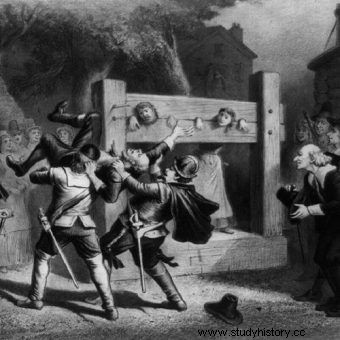
The Salem witch trials ended with one of the greatest tragedies in American history. But why did it happen at all?
The pioneers approached the subject of practicing black magic with a great deal of sense and distance. Or so they seemed. How wrong this was was found in 1692 by the inhabitants of the small town of Salem in the northeast. The town then witnessed the bizarre events that led to the most famous witch trial in history.
New World without stacks
There was no sign that events would take such a tragic turn. When allegations of witchcraft were raised, American courts usually imprisoned the defendants, sentenced them to exile or… acquitted. In addition to rescued lives and cleared names, the acquittal was also driven by the possibility of accusing the informers of defamation - and thus receiving compensation, which also happened.
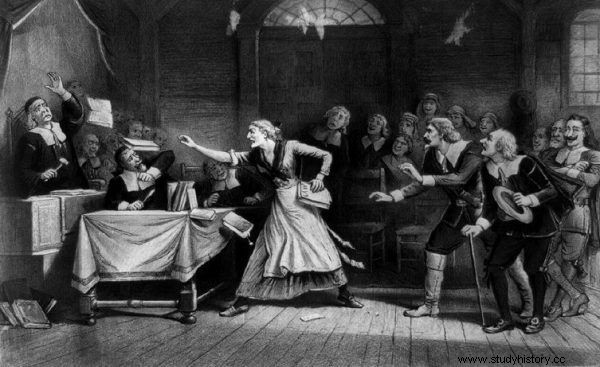
The principle of the presumption of innocence was not in force in the 17th century. The accused had to prove that they had not committed the alleged acts. It was not easy, especially since admissions of guilt were often forced by torture.
The people of the New World seemed to realize what was really behind the black magic suspicions - human hostility and malice towards people who, for some reason, differed from others. A great example is the Pennsylvania trial against two alleged Swedish witches.
Although the women were reprimanded that they had sued themselves through their bad behavior, the court acquitted them - nothing illegal was found in their alleged magical deeds. As reported by Kurt Baschwitz:
William Penn, the founder of the Pennsylvania colony, was present at the trial. [...] he was supposed to ask one of the accused: "Are you a witch? Have you ever flown on a broomstick? ” . The frightened woman admitted it right away, to which Penn stated that she had an undeniable right to fly herself on a broomstick, as there was no law forbidding her.
It wasn't just Pennsylvania who was skeptical about witchcraft accusations. It was similar in New York (formerly known as New Amsterdam). The city, despite joining the British colonies, still retained its Dutch influence. Probably thanks to this, the few trials in this region did not end with convictions anyway.
So what made Salem stand out on the map of the New World? And what caused the most famous witch trials to take place there?
A borderland
As the obsession with black magic exploded in Salem, the piles of burning people suspected of having contacts with Satan in Europe died out. And although in the eighteenth century there were still single processes, the paranoia that gripped the Old Continent at the turn of the sixteenth and seventeenth centuries has already burned out. So why did all prejudices and suspicions suddenly revive in the distant New World? This is how Stacy Schiff describes these areas in the book "Witches. Salem, 1692 ”:
The Salem village owes its existence in part to the fear of an ambush. The same name, established in 1629, was borne by the oldest city in Massachusetts Bay, almost the capital of New England. […] There weren't many better places in the entire colony; the exquisite port was second only to that of Boston. The city traded profitably with Europe and the West Indies. […] It was calmer, less cosmopolitan than Boston, but just as elegant. […]
In the 1740s, farmers began to migrate north and west, further and further away from the prosperous port, beyond the hills to more fertile lands. They formed a large settlement, also called Salem (now it is in the Danvers area).
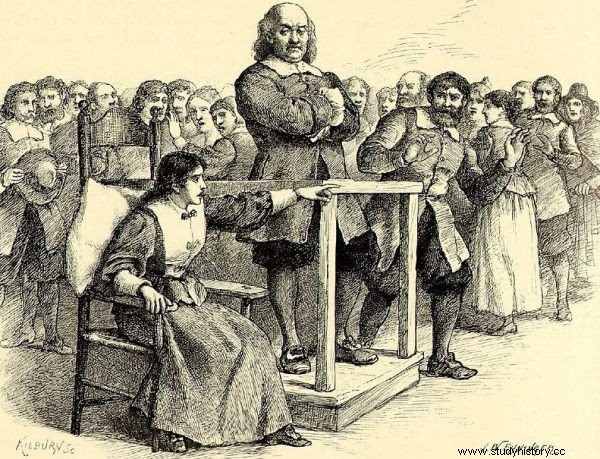
In Salem it all started with two little girls who were soon joined by a group of teenagers accusing various people of witchcraft, in many cases completely alien to them.
At first glance, these areas seemed modern, lively and rapidly developing centers. Unfortunately, it was only the first and very deceptive impression that faded with the closer acquaintance with the inhabitants of these areas - the Puritans.
In the grip of superstition
In this seemingly peaceful and Christian society, belief in the existence of black magic functioned on a par with the belief that what is recorded in the Bible is true. And this is the only right one around which the life of both the individual and the whole community should be built. Stacy Schiff in the book "Witches. Salem, 1692 ”writes about the Puritans:
Having suffered a great deal of faith, they sailed to North America to practice their religion "in a purer purity and free from the dangers of the land where they lived until now" […]. They considered the Reformation an unfinished project and the Church of England not virtuous enough. […]
They were prone to conflicts and factions, to formulating firm judgments, to lofty indignation. [...] They did not tolerate other faiths, they were fierce and fearful at the same time, confident, cruelly rational, not entirely American. They created the most homogeneous culture in the history of the continent.
Such people largely inhabited the state of Massachusetts. They lived on the edge of the world. Behind the copper, in the forest abyss, Indians and hostile French lurked. There were stories among the settlers of mysterious kidnappings and brutal murders by savages. In addition, there were crop failures, smallpox epidemics and poor relations with London. All of this only deepened the sense of isolation of this conservative community.
News from Europe reached overseas with a long delay. More than once, the colonists did not know about the political or military crises taking place in the Old Continent. It's fair to say that the people of New England lived out of time , to the rhythm of local events that were limited to their immediate surroundings.
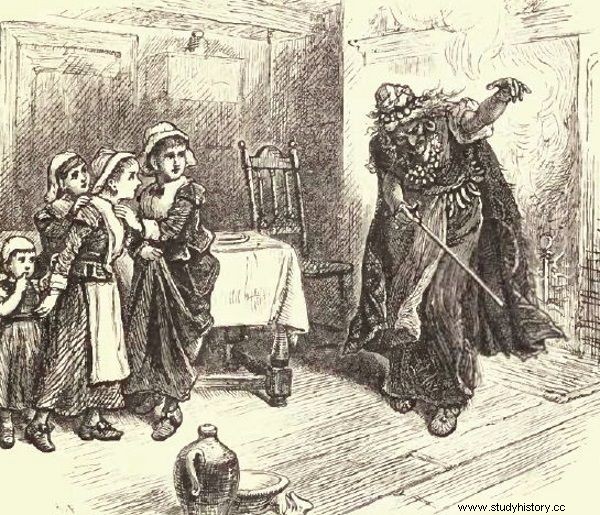
Among the first three accused in Salem was a black slave named Tituba. She was supposed to use magic to induce mysterious convulsions on her master's daughter and her cousin.
In this atmosphere of mutual distrust, suspicion and fantastic stories from the border between the real and fictional world, girls grew up who, according to Stacy Schiff, sent on a noose:"fourteen women, five men and two dogs". Not counting those who died in prison.
Satanic paranoia
According to Marvin Harris, the witch-hunt was a kind of regulator, protecting the establishment (both secular and spiritual) from the protests of the poor for a better life. However, this diagnosis is not entirely consistent with what happened in Salem.
So what really contributed to the panic in the small town? It is difficult to give an unambiguous answer. The local society was tense for a long time. Winner of the Pulitzer Prize in the book "Witches. Salem, 1692 "writes:" In isolated settlements, in dark, smoky houses you lived in the dark, and in the darkness you listen more carefully, your imagination works more vividly and what is holy and secret blooms ”.
Moreover, the Puritans believed that by their arrival they freed New England from the hands of Satan. As Stacy Schiff reports in Salem, “almost everyone had a Bible at home. Biblical images kept recurring in thoughts, dreams, punishments and dreams. […] Witchcraft was a favorite ominous omen. ”
It was in this atmosphere that a few girls who were bored and reluctant to do household chores were brought up. Listening to the thrill of stories told by the servants and experiencing the brutal life in the shadow of Native American attacks, it started one of the most famous tragedies in North American history.
What happened in Salem?
“It all started with two girls. Soon they were joined by a group of teenagers who were cast under the spell by a variety of people, in most cases completely alien to them, ”writes Stacy Schiff. The pastor's nine-year-old daughter, Betty Parris, and her eleven-year-old cousin, Abigail Williams, unexpectedly developed mysterious convulsions. They had seizures; they made terrifying noises during their attacks . Concerned about their behavior, Betty's father, Samuel Parris, brought Dr. William Griggs home, and it was he who made the diagnosis:girls are under the influence of witchcraft.
At this point, the Parris slave, Tibuta, overwhelmed by the events in the master's house, decided to help. Inspired by the advice of one of the neighbors, she prepared a flatbread, one of the ingredients of which was the urine of girls, and then gave it to the dog to eat.
This did not lift the curse on the girls, but contributed to their identification of the first witches. They were:the local beggar Sarah Good, "enjoying" a bad opinion, sick Sarah Osborne and Tibuta herself. The first two strongly denied the accusations, but the slave confirmed everything - and thus saved her skin. As Baschwitz points out:" Only women and men were hanged who persistently refused to admit that they were guilty of the offense of witchcraft . It was one of the many peculiarities of the Salem trial. ”
The first three hearings initiated a tragic series of trials, as a result of which several defendants were hanged on a noose, some died in prison, and one person during torture. The grounds for the allegations varied. From different looks or behavior to mutual animosities in the family and neighborhood. The girls also made accusations against those who openly questioned the legitimacy of the whole action, and at the same time gave an amazing display of acting skills. Screaming, throwing themselves on the floor and whistling in convulsions - these are just a few of their "signature" numbers.
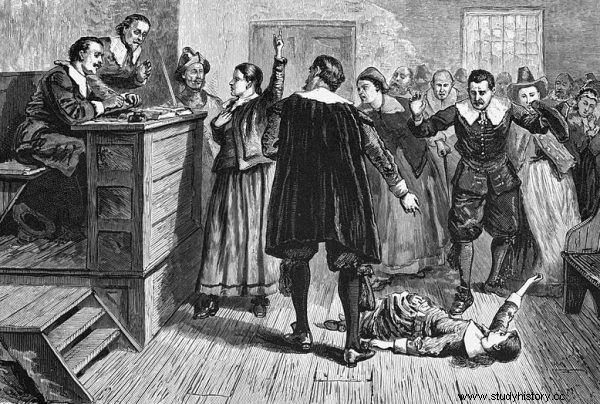
The girls who made the accusations in Salem displayed extraordinary acting skills. Their signature number was convulsions and demonic screams.
The principle of the presumption of innocence was officially introduced only at the end of the 18th century. Previously, the accused had to prove their innocence, which is why it was so easy to get people to confess to acts they did not commit. The pressure from the interrogations made it practically impossible to defend himself . And in Salem, only a quick admission of guilt gave a chance of survival.
The madness lasted from March to October 1692. The last trial in Salem took place in January 1693, when forty-nine people who had previously awaited conviction for practicing black magic were acquitted. As Stacy Shiff writes:"Witch trials are a cobwebbed folk tale with a stern moral reminding us that, as one pastor who watched the entire crisis with an unfavorable eye wrote, utter righteousness can breed outright evil."
Bibliography:
- Kurt Bashwitz, Witches - history of witchcraft trials , Cyclades 1999.
- Marvin Harris, Cows, pigs, wars and witches:the mysteries of culture , State Publishing Institute 1985.
- Jean-Michel Sallmann, Witches. Satan's Bride , Dolnośląskie Publishing House 1994.
- Stacy Shiff, Witches. Salem, 1692 , Margins 2019.
